IPM 7 Fighting Varroa The Arsenal: “Natural” Treatments – Part 2
IPM 7 Fighting Varroa
The Arsenal:
“Natural” Treatments – Part 2
© Randy Oliver 2007
ScientificBeekeeping.com
First Published in ABJ in September 2007
(Tenth in a Series on Integrated Pest Management of Varroa)
Let me tell you, researching and writing this series has been an education for me! Several of my preconceived notions have been stood on their heads. One treatment—powdered sugar—that I had dismissed as impractical, turns out to be surprisingly effective. I’ve got less of an “attitude” against Apistan and amitraz. Even scary, lung-searing formic acid has been tamed by MiteAwayII. But the most important thing is that by really understanding the mite/bee relationship, and taking some simple steps, I hope to be able to approach varroa as an annoyance, rather than as a fearsome, mysterious enemy threatening to decimate my colonies.
This week I dusted 100 lbs of powdered sugar one morning. My two sons and I figured out how a three-man crew could blast through yards of 36 colonies in 15 minutes without breaking a sweat. Not bad, but clearly, the market is ripe for a truck-mounted blower that can puff two cups of sugar dust into each hive (I’m still determining if dusting is a commercially viable option). Today I tried the suggestion of using outgassed MiteAwayII pads for smoker fuel—what a pleasant surprise! Easy to light, long burning, and such a sweet-smelling smoke. Good call, David!
Disclaimer: I am not licensed to make any pesticide recommendation. I am
merely reporting on published information. You should consult your local authority for recommendations.
The essential oils
As you may recall from the last installment, the “natural treatments” consist mainly of organic acids and essential oils. Essential oils are volatile oils extracted from aromatic plants, thereby capturing the “essence,” or characteristic odor of that plant. Plants produce aromatic oils (other than those in the flowers) in order to deter or poison insects or other animals that might otherwise eat the plant, or to prevent bacterial or fungal growth. Although many of the essential oils smell good to humans (such as cinnamon or wintergreen), they are clearly poisons and/or irritants when concentrated.
A wide variety of essential oils (over 150) from culinary herbs and spices, perfumery, traditional medicine, or natural pesticides have been tested as potential varroacides. Several have shown promise, but the standout is thymol.
Thymol
Thymol is a phenolic monoterpene extracted from garden thyme. We all are familiar with its antiseptic odor from Listerine® and similar products. Thymol is sold as a white crystal, which is relatively safe to handle if there is good ventilation, and nitrile gloves are worn. The standard dose is 8 – 12g of pure thymol, applied in dishes on the top bars, repeated two to three times. Unfortunately, the evaporation rate of pure crystals is extremely temperature dependent. They can evaporate too quickly in warm weather, and kill bees and brood, since the lethal concentration of thymol to bees is only some 2-4 times that which kills mites. Use of pure thymol is not registered in the U.S., although many kitchen chemists have developed home recipes that mix thymol with shortening, vegetable or mineral oil, and perhaps other essential oils, and apply the concoction on a saturated shop towel or bar coaster.
Thymol has the added advantage of being active against fungus (chalkbrood) and tracheal mite (to some extent). Unfortunately, it can also leave honey with a “Listerine” taste. Thymol acts as a fumigant (although it doesn’t kill many mites in the brood) —all cracks and holes in the hive need to be sealed, and screened bottoms blocked. Thymol also has a relatively narrow temperature window for application—roughly 60° – 90°F.
Update: Apiguard gel can be used up to 105F, but at the 50-g application rate, will be noticeably disruptive to the bees and the broodnest at that temperature.
I detailed how to determine the temperature window for your location in my last article. I’m including one for the East Coast here.
In the U.S. there are two registered formulations containing thymol: ApiLife Var (wafers) and Apiguard (gel). Each generally requires three trips to the apiary, although small colonies may realize acceptable mite control with only one treatment. I’ve scoured the literature for trials of the two products, and include a few in the references at the end of this article. If properly applied, either product generally gives a 65% or better mite kill, more generally in the 90 – 95% range. In some trials, one or the other performed better, and I can’t recommend one over the other. Some notes of interest are that there was often great colony-to-colony variability in efficacy, and that colony development was sometimes suppressed for several months after treatment.
ApiLife Var®
This product of Italy has been around for over 15 years. It comes in a foil wrapper containing a plastic bag with two soft vermiculite wafers consisting of 74% thymol, 16% eucalyptol, and 3.7% each of menthol and camphor. The eucalyptol makes it eye-watering “aromatic” (gotta be good medicine if it smells strong), but the thymol is apparently the agent responsible for actually killing mites. It is impossible to talk about ApiLife without mentioning that it has a strong smell!
In yet another example of silly safety labeling, the label reads: “Applicators…must wear…chemical resistant footware and socks [and] waterproof gloves.” Does this mean chemical-resistant hosiery? And why waterproof gloves for a product whose active ingredients are nearly insoluble in water? Who writes this stuff anyway? I’d sure wear nitrile gloves! When I handled a wafer barehanded, I soon felt a tingly burning on my skin, like an amped up muscle rub. My eyes watered if I got my smelly fingers anywhere near them. ApiLife will quickly break you of any habit of casually touching any part of your face while you work!
The instructions on the package are in Italian, with a sticker in English. Directions are minimal—here’s how to use it. Open the foil and plastic wrappers carefully (the wafers are very fragile), and remove the two wafers (wearing gloves). Then break each wafer into four “equal” pieces (I have no idea why they don’t do it for us), and place four pieces in a circle (square?) on the top bars of each hive, under the lid. ApiLife needs to be applied three times at 7-10 day intervals. One package treats two colonies once—you’d need three packages to treat two colonies for the full course of treatment (a little pricey).
ApiLife’s website makes a helpful suggestion: “In case of high temperatures, above 30°C [86°F], accustom the bees to the scent of the tablets by placing a small piece of it in the hive the day before.” This suggestion may give you a clue to the fact that bees sure don’t like the smell! You can hear a colony roaring from several feet away as it attempts to fan out the fumes.
I didn’t note any significant brood kill in my limited trials—eggs, larvae, and pupae continued to chug along largely unfazed. Overall, my favorite response to my questions about ApiLife was from a commercial beekeeper whose crews applied thousands of strips a few years ago: “Overall; it kills mites ….sorta….and it stinks.”
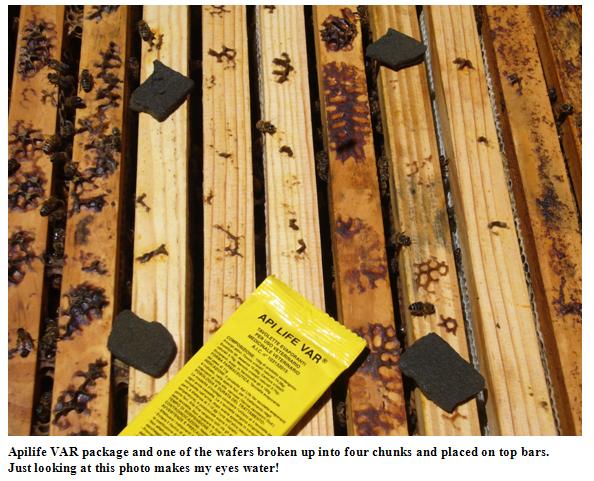
Apiguard®
This newer product, manufactured by a British company, consists of 25% thymol dissolved in a cross-linked polyacrylic acid gel. The gel serves two purposes: it regulates the release of the thymol at varying temperatures, and it serves as a carrier that causes the bees to “track” thymol throughout the hive as they remove it. The product is sold either in either cute little single-use aluminum trays, or as bulk gel in a bucket. The bulk gel needs to be stirred before use, since the components may separate during storage.
A 50g dose of Apiguard contains 12.5g of thymol. The instructions call for it to be placed on a nonabsorbent pad on top of the upper brood frames, with at least 1/4” space above. One of the published trials neglected to allow bees this access space, and no gel was removed by bees. Not surprisingly, mite control suffered. Palmeri (2007) found that the tracking of gel resulted in about 5% more mite kill.
Update: see 2015 Test of Late Summer Varroa Treatments (soon to be linked).
https://scientificbeekeeping.com/a-test-of-late-summer-varroa-treatments/
Apiguard is applied twice; the second dose two weeks after the first. The instructions suggest that “The effect of Apiguard is maximized if the product is used in late summer after the honey harvest (when the amount of brood is diminishing).” However, their website states: “Apiguard can be used in springtime, if necessary, provided the daily temperature is high enough. However, it is not the best time to apply the product. Thymol, which is the active ingredient in Apiguard, can sometimes make the queen stop egg laying for a short period and that is not what is needed in early spring – the colony needs to be growing. If the mite infestation is high in spring then it is safer to use Apiguard rather than let the mites reproduce further but treatment is otherwise best left until the summer.”
Their website also states that: “Apiguard® has no harmful effect on the honeybee colony, neither on brood nor on adults.” The caveats are that weak colonies should be combined before treatment, and that the product not be used when maximum daily temperature is above 105°F.
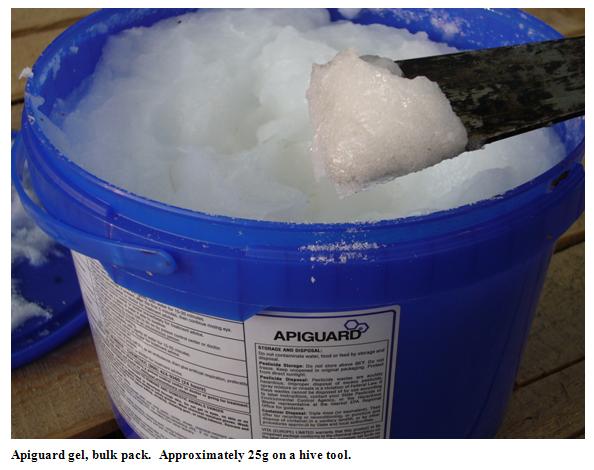
OK, I’ve told you what the manufacturer claims. Now, what is the field experience of beekeepers who have used it? At first, the adult bees are somewhat repelled by the smell, and keep their distance from the gel. The colony may fan loudly and beard up in front during application on warm days. After Apiguard has outgassed some, the bees then gnaw away at it and remove it. By the second dose, the bees are somewhat accustomed to the odor, and may not remove the gel as quickly. After the gel is gone, the bees may either propolize the cardboard pad, or chew it up and remove it completely.
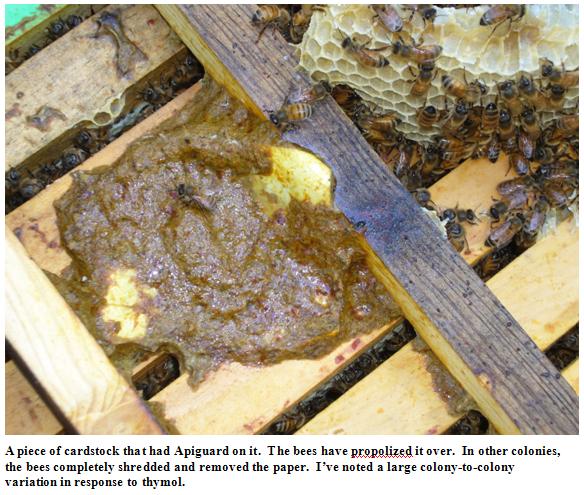
The manufacturer claims that Apiguard is safe for the brood. However, in my limited trials, the brood initially gets hit hard. I’ve included two photos showing the type of brood damage that occurs in short order. These colonies were treated in the late afternoon with 25g (a half dose) of Apiguard on the top bars of strong double deeps. I used a 1-1/2” spacer rim to allow ventilation space below the hive cover. I took the photos the next day at noon, when the temperature had reached 76°F. The photo shows a typical brood frame, pulled from the center of the upper brood chamber, below the Apiguard gel. As you can see, the bees had removed most of the larvae, and in were in the process of removing pupae. The other photo is of a stickyboard placed below a screened bottom. The pile of debris is typical—consisting largely of pupal legs that appear to have been sucked dry. Note the large number of pupae initially killed relative to the number of dead mites!
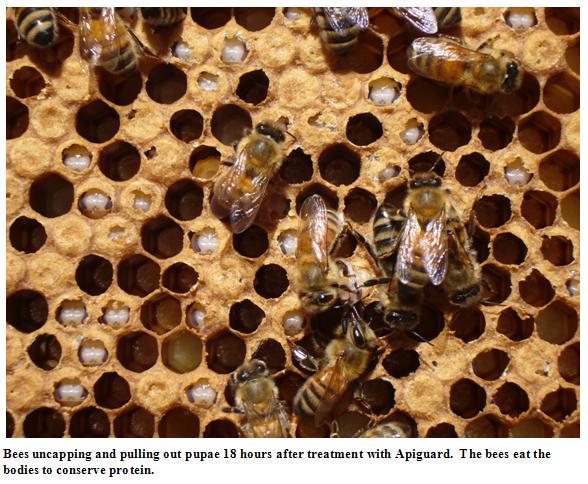
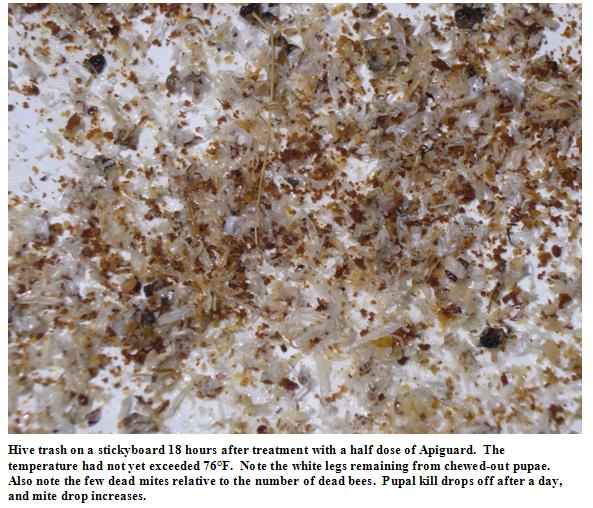
I’ve spoken with other beekeepers, and they hadn’t noted the extensive brood kill that I have. However, comments included treatment causing supesedure or loss of older queens, and in fall, of older bees. Some Northern California beekeepers were not happy with treatment during our very hot fall weather last year. The queens stopped laying during treatment, resulting in fewer young bees going into the winter cluster.
One commercial beekeeper felt that Apiguard worked better when applied in the space between the brood chambers. He also felt that a springtime treatment in the almonds worked well. Some report good results when applied at 7-day intervals. Another suggestion was to make sure that you use a nonabsorbent pad–sometimes the gel dries too quickly in hot, dry weather.
Dr. Frank Eischen, of USDA ARS, recommends using only “ 25g of Apiguard 3x at about weekly intervals anytime the mid-day temperatures reach the low to mid 80s. If 50g are used, the beekeeper will likely see pulled brood.”
Update 2/2008: Don’t let the brood kill scare you! Use only 25g in hot weather, applied between the brood chambers. The colony will quickly recover from any brood loss, and it is far better to lose a bit of brood, than to lose the whole colony to mites! I’ve used this product quite a bit more, and am impressed by its ease of use and efficacy.
Update 8/08: I have used Apiguard extensively. I prefer to apply it to common 3×5 cards, and place it between the brood chambers at the back of the hive. The bees shred and remove the cards, leaving no foil to clean up. If you calibrate the size of scoops on your hive tool, you can quickly scoop the gel onto cards in the field (and adjust for colony size). In warm weather use 25g per strong colony, repeated in a week to 10 days. Use less for smaller colonies (only a dab for nucs) or you will see significant brood kill (again, brood kill is only a temporary loss, and worth it if the mites are really hammered).
If you apply Apiguard under the cover, its efficacy is increased by using a rim to lift the cover so as to allow dispersal of the vapors.
During hot weather, Apiguard gel may separate into a clear liquid and white waxy semisolid. I asked Dr. Max Watkins about this, and about using Apiguard with screened bottoms. His reply:
Apiguard will work with screened bottom boards but we have seen improved efficacy where the bottoms are closed off during Apiguard treatment. This is probably because gel worked by the bees can be lost from the hive, falling out of the bottom screens whereas with closed floors, the bees have to take the gel right down to the hive entrance to get rid of it. Thymol vapour is heavier than air and with the air currents circulating in the hive it could be that thymol vapour is lost more readily through the screen. The difference in keeping screens on open or closed during Apiguard treatment is not huge and indeed may not be significant but we and many of our users believe that the mite kill is more effective with the floor closed off. It’s a matter of choice.
If Apiguard is stored above 38ºC – 40ºC, (100.4ºF – 104ºF) the gel matrix separates into aqueous and solid phases, irreversibly. While the thymol is still active and useful, the gel structure will be changed. Apiguard really has to be stored and transported at temperatures below 100ºF.
Thymol bottom line
The upside is that thymol has a proven record for controlling mite levels, is relatively nontoxic, and doesn’t leave long-term residues. There are indeed residues, but those in the honey are generally below taste threshold, and those in the wax dissipate in some weeks. One thing that surprised me is that the mite drop is delayed—you don’t get the major initial drop that is seen with other products.
The downsides are that either product takes at least three trips (if you include removing the rim for Apiguard) to the beeyard. As with formic acid, the utility of thymol is very much limited by its temperature restrictions-it is only effective in a fairly narrow temperature window of roughly 60° – 90°F. Bees don’t like it much. They fan, they get “pissy,” they may tear out brood. Queens may shut down egglaying, run out of the colonies, or be superseded. In general, it’s pretty disruptive to the colony. This may be an issue if it occurs during the critically important late summer production of future “winter bees.”
I realize that the downsides seem pretty harsh. Let me temper them by stating that both products have successfully been used to keep colonies alive, and beekeepers in business, for some years. My take is that we’re still on the learning curve with thymol.
Update 8/08: Although my statements above are true, my experience with both thymol products are that they work well, and that the disruption to the colony is outweighed by the good control of varroa.
Other thymol products
There are other thymol products sold elsewhere in the world, such as Thymovar and Thymomite. One especially clever product is Exomite Exomite™ Apis (www.exosect.com/solutions/products/exomite_apis.asp). This company has developed an extremely fine wax powder that carries a strong electrostatic charge. The particles can be impregnated with lipophilic chemicals, and used to dust insects or mites, thus covering them with a coating of the active ingredient. In this case, the active ingredient is (you guessed it!) thymol. The product shows good test results, but is quite pricey. In any case, their delivery system may well be useful in other honeybee applications.
Other essential oils
Acarologist (someone who studies mites) Dr. Jim Amrine, working in conjunction with beekeeper Bob Noel maintains an up-to-date website on mite control in honey bee hives with essential oils and formic acid fumigation at: (Broken Link!) http://www.wvu.edu/~agexten/varroa06.htm. There is a wealth of information on essential oils there.
They have developed a four-part protocol for mite control consisting of:
1. Screened bottom boards
2. Feeding two essential oils: spearmint and lemon grass (constituents of Honey B Healthy TM, a product now marketed by Noel)
3. Feeding wintergreen/salt/grease patties (the salt is surprising to me, since it is generally considered toxic to bees), and
4. Their 50% formic acid fumigator: details on their website.
I’d be very happy to hear from any beekeepers who have used this system.
Kitchen chemists and oils
Since the essential oils are so much fun to play with, numerous beekeepers have indulged in kitchen chemistry to mix up varroa treatments. We don’t hear much from those who kill their bees outright, nor from those whose colonies die later due to lack of efficacy or colony stress due to the treatment. Those whose bees survive for a season generally post their recipe to the internet, where it gains a cyberlife, independent of its actual efficacy.
If it were easy to come up with an inexpensive application method for essential oils, those clever (and desperate) Europeans would likely have done so by now. The “margin of safety” between the dose that kills mites, and the dose that kills bees is narrow. In addition, evaporation is extremely temperature sensitive. Add to that the fact that individual colonies respond differently to the treatment—some will propolize up the material, some will quickly remove it, some fan it away from the broodnest, and others remove the brood.
Experiment if you will, but don’t bet your whole operation on an unproven recipe! Do your homework—start with the two Canadian Honey Council pages in References. Some oils are toxic to bees or humans (and can be absorbed through the skin). Some have unexpected side effects: Henley, et al. (2007) found that “Lavender and tea tree oils found in some shampoos … can temporarily leave boys with enlarged breasts in rare cases, apparently by disrupting their hormonal balance…”
I read lots of recipes for white vinegar, mineral or vegetable oils, and garlic powder. Again, there are major questions as to their usefulness. My friend Luigi came up with a surefire varroa home remedy consisting of vinegar, olive oil, garlic, thymol, rosemary and oregano oils. All his colonies died, unfortunately, but the rest of the batch made great salad dressing!
The “fixed” oils–vegetable or food-grade mineral oil (FGMO), or hydrogenated shortening (Crisco) are also often used. Although grease or oil patties have been proven to be effective against tracheal mite (by disrupting its questing behavior), I haven’t had any luck in finding verifiable data demonstrating success in using fixed oils to control varroa. However, fixed oil may be useful as a carrier to distribute essential oils. Indeed, the specific type of oil carrier greatly affects the absorption and excretion of essential oils (Wilson & Isman 2006). This brings me to the “shop towel problem.” Experimental beekeeper Grant Gillard wrote me: “One of the limitations of greasy towels is that bees have to physically interact with the paper towel to receive any benefits. Some colonies of bees totally ignore the greasy paper towels and they gain no benefit from the towels being placed in the hive. Some colonies are great propolizers. They will encase the oily paper towel with propolis rather than shred it, and again, it does them no good. This is where the fogged FGMO is superior to greasy paper towels. It will get to the bees that would normally ignore the paper towels.”
Oh my gosh! Fogging with a Burgess fogger. Lots of bees have been killed. Numerous fires started when the fog hit a spark from a smoker. Not to mention what oil fog does when you breathe it: “While repeated exposure to conventionally-refined mineral oils may cause pulmonary disease as well as severe dermatoses and cancer of the skin and scrotum, lipoid pneumonia is the major health hazard associated with highly refined mineral oils … While the course of lipoid pneumonia can be asymptomatic in some individuals, in others its symptoms can range from occasional cough to severe, debilitating dyspnea and pulmonary illness, occasionally ending in death.” (Palmer 1990). Think twice before you go exposing yourself to an aromatic toxic fog—there are safer ways to deal with the mite!
If you’re going to experiment, keep good records, and run untreated colonies as “controls.” Your results are meaningless unless you compare them to similar colonies that weren’t treated. Take regular mite counts before, during, and after. Look closely for deleterious effects to the colonies. The bees definitely notice when essential oils are applied, and that may affect their behavior. Treatments may have short- or long-term effects upon egglaying, broodrearing, and food storage, resulting in poor wintering, or slow spring buildup. One beekeeper who is a keen observer noticed: “It seemed that a lot of queens had trouble returning from mating flights. I would find them running around the outside of the nucs, unable or unwilling to use the entrance of a nuc with an essential oil treatment. The queens properly oriented a few days after the treatments were removed.”
ARS research on essential oils
The Agricultural Research Station, Tucson, led by Dr. Gloria DeGrandi Hoffman, is looking at new delivery systems for essential oils. The idea is to get an essential oil into the blood of the bees and repel the mites from feeding. Dr. Gordon Wardell is looking at ways to feed syrup or liquid protein diet containing essential oils in suspension. In addition, Fabiana Ahumdada-Segura of the University of Arizona-USDA is working on delivering essential oils of thymol, origanum, clove, and cinnamon microencapsulated in cornstarch. The process for microencapsulation turns food-grade cornstarch into a microcellular gel that the essential oils are then incorporated into. The product is ground to the fineness of pollen, mixed with powdered sugar, and dusted into the beehive.
Other “natural” treatments (or dang near natural)
Sucrocide®
When researchers were investigating how tobacco plants killed insects that walked over them, they were surprised to find that it wasn’t the nicotine that killed them–it was soapy sugar esters that caused the insects to lose water through their skins and desiccate. Several synthetic analogues were developed as foliar sprays to control small greenhouse pests. Dr. Steve Sheppard tried a sample of sucrose octanoate against varroa, had promising results, and the evolution of the product Sucrocide was detailed in a series of articles in this magazine.
Sucrocide gave great mite kill in field trials, but results were erratic in the field, ranging from highly effective to “I might as well have been spraying water.” No one knows what the problems were, but it was a great disappointment. The manufacturer still sells the product for agricultural uses, but the company rep told me that the bee market is so small as not to justify further private testing. However, trials are underway in Chile and Europe. Perhaps stronger concentrations or some other tweaking will eventually get it to work reliably. Meanwhile, I find that the local legal marijuana growers here in California just love Sucrocide for control of spider mites (you might be surprised at the various consulting requests that come my way!).
I’m still eager to hear from beekeepers who are successfully managing varroa. Tell me what’s working for you, and I’ll share it for the benefit of all. All my previous articles are available at http://www.scientificbeekeeping.com Grant Gillard can be reached at gfcg7312003@yahoo.com This e-mail address is being protected from spam bots, you need JavaScript enabled to view it . Thank you to all the unnamed beekeepers for your time in interviews.
References
Great manual on available chemicals (from New Zealand):
(Broken Link!) http://www.biosecurity.govt.nz/files/pests/varroa/papers/varroa-treatment-options.pdf
Canadian Honey Council webpages on essential oils:
Botanicals for mite control: (Broken Link!) http://www.honeycouncil.ca/users/folder.asp?FolderID=5214
Essential Oils and their Toxicity to Honeybees (Broken Link!) http://www.honeycouncil.ca/users/folder.asp?FolderID=5220
Adamczyk, S, R Lázaro, C Pérez-Arquillué, P Conchello, and A Herrera (2005) Evaluation of Residues of Essential Oil Components in Honey after Different Anti-Varroa Treatments J. Agric. Food Chem., 53 (26), 10085 -10090
Floris, I A Satta, P Cabras, VL Garau, and A Angioni (2004) Comparison Between Two Thymol Formulations in the Control of Varroa destructor: Effectiveness, Persistence, and Residues. J. Econ. Entomol. 97(2):187-91.
Gates, J and A Melathopoulos (2005) Thymol has Potential for Varroa Mite Control in Canada Hivelights 15(1):15-16.
Henley, DV, N Lipson, K Korach, C Bloch (2007) Prepubertal gynecomastia linked to lavender and tea tree oils. New England Journal of Medicine 356 (5): 479-485.
Mutinelli, F., Baggio, A., Arculeo, P., Nanetti, A., Marinelli, E. (2004) Field trials with different thymol-based products for the control of varroosis. ABJ 144(5):395-400.
Palmer, Winifred G. (1990) Exposure Standard for Fog Oil. ARMY BIOMEDICAL RESEARCH AND DEVELOPMENT LAB FORT DETRICK MD
Palmeri, V, O Campolo and L Zappalà (2007) Evaluation of two methods for applying Apiguard® in an area with continuous nectar flows and brood rearing. JAR 46(2): 105-109.
Skinner, A, J Tam, R Bannister, M Kempers (2007) Evaluation of SucrocideTM as a treatment to control varroa mites in Ontario. The Sting Feb 2007: 33-36.
Stanghellini, M. S., Raybold, P. (2004) Evaluation of selected biopesticides for the late fall control of varroa mites in a northern temperate climate. American Bee Journal 144(6): 475-480
Melathopoulos, AP, ML Winston, R Whittington, H Higo, M Le Doux (2000) Field Evaluation of Neem and Canola Oil for the Selective Control of the Honey Bee (Hymenoptera: Apidae) Mite Parasites Varroa jacobsoni (Acari: Varroidae) and Acarapis woodi (Acari: Tarsonemidae). J. Econ. Entomology 93(3): 559-567.
Wilson, JA & MB Isman (2006) Influence of essential oils on toxicity and pharmacokinetics of the plant toxin thymol in the larvae of Trichoplusia ni. The Canadian Entomologist 138 (4): 578-589.



